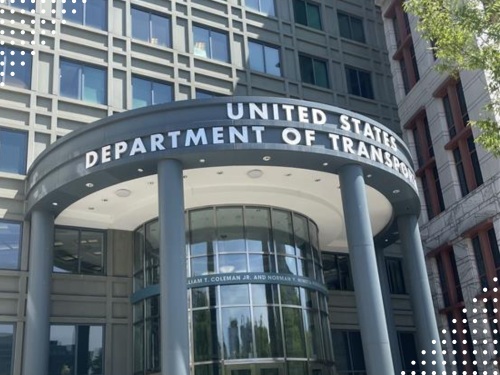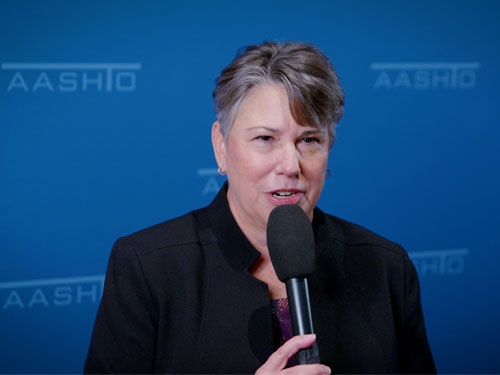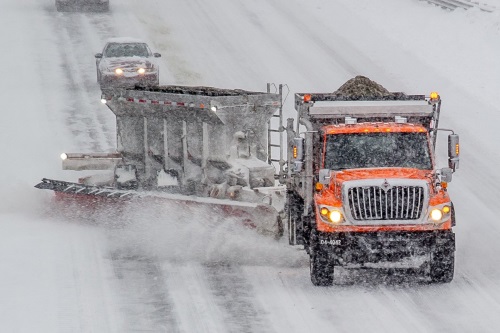Several state departments of transportation are facing winter operation challenges created by COVID-19 as the pandemic is leading to budget tightening as well as greater health and safety needs among their snowplow driver corps.
[Above photo via the Michigan DOT.]
“Over the years, maintenance workers at the state and local levels have handled everything winter could throw at them but, with the continuing threat of COVID-19, this is going to be an unprecedented winter,” explained Paul Ajegba, director of the Michigan Department of Transportation, in a statement.
“We’re working with local agencies and county road commissions to plan for contingencies, but we want drivers to know the pandemic could affect our ability to maintain winter levels of service,” he said.

He stressed that while the central winter operation goal of the Michigan DOT and its partner agencies remains the same – clearing highways to bare pavement as quickly as possible after a winter storm – COVID-19 infections or associated quarantines of agency and contractor personnel could lengthen the time it takes to reach that goal.
“During snowstorms, Michigan DOT and our contract agencies will have all available staff out working to clear roads as quickly as possible,” Ajegba added. “We’ll be asking the public for their patience and understanding if we need to manage temporary staff shortages. We’ll do the best we can with the resources available.”
[Editor’s note: Two years ago the Michigan DOT and Michigan State Police jointly produced the video below, which details how roads are maintained in the winter and the actions motorists should take to be prepared for inclement driving conditions.]
Meanwhile, the Wyoming Department of Transportation faces an additional challenge due to COVID-19 as the pandemic has reduced state transportation revenues the agency relies upon to fund its winter road maintenance activities.
As a result, the agency plans to strictly adhere to its “snowplow priority plan,” which prioritizes snow removal operations based on road traffic volume – with school bus routes and major highways continuing to be “top priority.”

Yet that also means while crews will still plow the roads based on traffic volume, the roads may remain “snowy” and not cleared to the bare pavement. Road shoulders also might not be plowed immediately, meaning crews will get to those sections later or the next day, the agency added.
“We want to assure the public that we will continue to maintain the roads during winter storms to ensure we provide a safe and effective transportation system,” explained K. Luke Reiner, Wyoming DOT’s director, in a statement. “Our crews will be out there diligently working to clear the roads.”
[Want to know more about snow and ice fighting tactics? Check out the winter operations podcast put together by the American Association of State Highway and Transportation Officials Snow and Ice Pooled Fund Cooperative Program, known as “SICOP.”]
Yet he stressed that the Wyoming DOT – like other state agencies – had to make budget reductions due to the revenue decrease caused by COVD-19. For example, the agency closed 10 rest areas located throughout the state on June 15 to reduce costs due to its budgetary shortfalls.
Then, in mid-July, the Wyoming DOT delayed 11 construction projects and reviewed local transportation programs due to “long- and short-term funding issues” caused by reductions in fuel tax revenues, petroleum market revenues, and other fees – with the COVID-19 pandemic expected to create “additional” budgetary impact as well.

“We are operating in unprecedented times exacerbated by the coronavirus pandemic and we need to look at every avenue to save money,” Reiner explained at the time.
“We are looking at ways to save money and streamline our processes so we can continue to provide the people of Wyoming with the best possible service,” he said. “These cost-savings measures will be challenging, but as a state we will get through this together and emerge stronger than before.”
Those same monetary strictures apply to Wyoming DOT’s winter operations plan as well.
“We will have to strictly adhere to our winter maintenance budget, which means there likely won’t be any wiggle room to go over budget if we have a particularly severe winter,” Reiner said. “However, we will continue to provide winter maintenance services based on our limited budget.”
[The agency also noted in a video report that a bevy of ‘behind the scenes’ personnel are critical to keeping its snow-fighting equipment ready to battle the elements.]
https://youtu.be/tIPQC6IUojg
The Washington State Department of Transportation is also grappling with a similar funding issue and is working to ensure it does not affect travel efficiency.
“This year, COVID-19 protocols could mean slightly longer road or pass closures, as well as more chain requirements during major storms, so we need everyone to be prepared and stay informed to help keep traffic moving,” explained James Morin, WSDOT’s maintenance operations manager, in a statement. “Our crews work hard to keep roads clear, but we need the public’s help as well.”

The agency added that there is a “follow on” cost to the winter season in terms of road repair needs.
Take the use of studded tires by motorists to improve road traction during the winter – tires that are legal for use in Washington State only from November 1 through March 31, even for vehicles traveling from other states.
WSDOT estimates studded tires cause between $20 million and $29 million in pavement damage to state-owned asphalt and concrete roadways each year, which is why the agency encourages residents to visit a tire dealer to learn about alternatives, such as stud-free winter tread traction tires that do not cause the same roadway damage as studded tires.
 Top Stories
Top Stories
USDOT Makes $1.5B Worth of BUILD Grants Available
December 19, 2025 Top Stories
Top Stories

